A proportional level-output detector for pilot plants
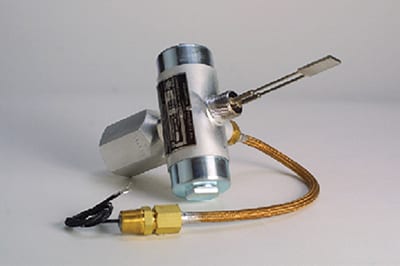
Dynatrol
The Dynatrol CL-10GP proportional level detector (photo) is designed to control liquid levels in pilot plants, chemical-processing plants and small vessels, or anywhere it is necessary to obtain proportional level control over a precise range. The EC-103C(G) control unit is paired with the detector and can activate electro-pneumatic transducers, valve positioners, indicators, controllers or other direct-current devices. The detector and control unit accurately monitor and control an extremely precise liquid level range due to its unique, high-resolution, proportional output signal. This unique control operates reliably under varying-frequency power supplies or harsh process conditions, such as high pressures and high temperatures. All units are built in accordance with Class I, Group D; Class II, Groups E, F & G; and Class III services. — Automation Products, Inc.; Dynatrol Div., Houston
Determine sulfur and nitrogen content in gases and liquids
Launched under this company’s Antek brand, ElemeNtS is said to be the most advanced modular-analytical system available for the detection of total nitrogen or total sulfur (or both) content in liquid or gaseous materials and liquified propane gas (LPG) samples. Three configurations are available: ElemeNtS-N for nitrogen analysis, ElemeNtS-S for sulfur analysis and ElemeNtS-N/S for simultaneous nitrogen and sulfur analysis. ElemeNtS combines extremely stable sulfur and nitrogen detectors with linearity up to 104. The new generation ElemeNtS displays exceptional sensitivity and allows simultaneous analysis of total sulfur and total nitrogen in hydrocarbon samples up to 30 parts per billion by weight (ppbw), according to ISO 11843. Featuring a 10 in. touch-screen, the ElemeNtS allows for direct queue control and diagnostics, along with a completely revamped IRIS-based software platform. ElemeNtS complies with key standard methods. — PAC LP, Houston
This ICP-OES analyzer is now twice as sensitive
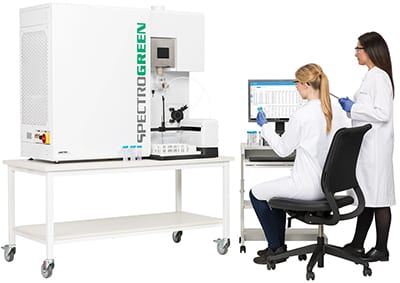
Spectro Analytical Instruments
The new Spectrogreen inductively coupled plasma, optical-emission spectrometry (ICP-OES) analyzer (photo) features a revolutionary Dual Side-On Interface (DSOI) technology that achieves twice the sensitivity of conventional radial-plasma-view instruments, at an attractive price/performance ratio. DSOI technology, a brand-new approach to the critical issue of plasma view design, uses a vertical plasma torch, observed via a new direct radial-view technology. Two optical interfaces capture emitted light from both sides of the plasma, using only a single extra reflection, for added sensitivity and elimination of issues that plague newer vertical-torch dual-view models. As a result, DSOI provides twice the sensitivity of conventional radial systems and yet avoids the complexity, drawbacks and cost of vertical dual-view models. — Spectro Analytical Instruments GmbH, Kleve, Germany
A cyanide analyzer for industrial wastewater
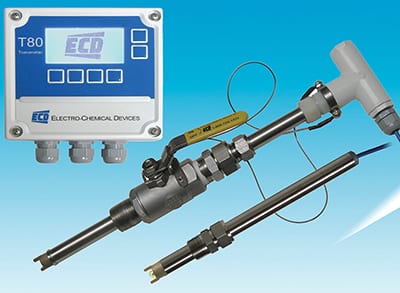
Electro-Chemical Devices
The S80-T80 cyanide analyzer monitoring system (photo) features an S80 Pion Cyanide Sensor and a dual-channel T80 Transmitter. The cyanide analyzer helps plants achieve a more cost-effective cyanide-removal water-treatment system, which ensures wastewater is treated to meet U.S. Environmental Protection Agency (EPA) regulatory requirements prior to effluent discharge. The S80’s CN-ion electrode is a combination electrode with a silver cyanide/silver sulfide solid-state pressed-crystal sensing element and a double junction reference electrode. The CN-ion selective electrode cartridge develops a millivolt potential proportional to the concentration of free CN ions in the measured solution. The typical output is 54–60 mV per decade of change in concentration. The sensor’s response time varies from a few seconds in concentrated solutions up to a few minutes in the lower parts per million (ppm) range. This analyzer measures CN from 0.2 to 260 ppm. — Electro-Chemical Devices (ECD), Anaheim, Calif.
Limit-value display simplifies process monitoring
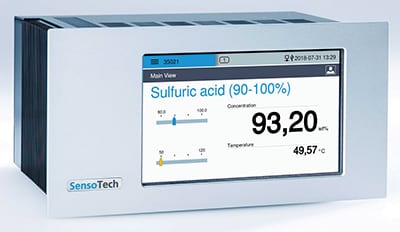
SensoTech
LiquiSonic systems (photo) measure concentration and density in process liquids by sonic velocity. In addition to displaying the numeric concentration, density and temperature, the LiquiSonic now also displays the limit-value ranges, which simplifies the monitoring of an approximation of critical values. Users can identify the segment in the measuring range where the current value is settled on and get a quick overview. The LiquiSonic controller display allows up to three value ranges at the same time. This applies for each one of the up to four sensors, which can be connected to a control unit. — SensoTech GmbH, Magdeburg–Barleben, Germany
New functionality for this sensor transmitter
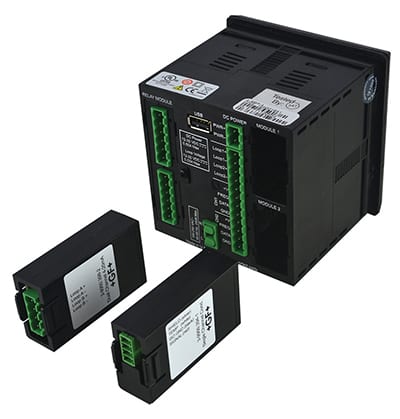
GF Piping Systems
This company has added the next-generation Signet 9950 dual channel transmitter (Gen 2b) to its flow and analytical instrumentation product line. The 9950 Gen2b adds extensive new functionality to its already proven capabilities that enable multiple measurement readings in one transmitter. This minimizes the number of transmitters needed, providing cost savings and greater convenience. The 9950 Gen 2b fully supports the Signet 2751 pH/ORP Smart Sensor Electronics for pH/ORP measurements. Additionally, the 9950 Gen 2b automatically measures pH glass impedance, detects broken glass and reads stored data in all Signet DryLoc pH and ORP electrodes. The 9950 Gen 2b also supports two new plug-in modules (photo): the Single Channel Direct Conductivity Module (3-9950.394-1) and the Dual 4–20-mA Current Loop Output Module (3-9950.398-2). — GF Piping Systems, Irvine, Calif.
Moisture analyzer with more communication capabilities
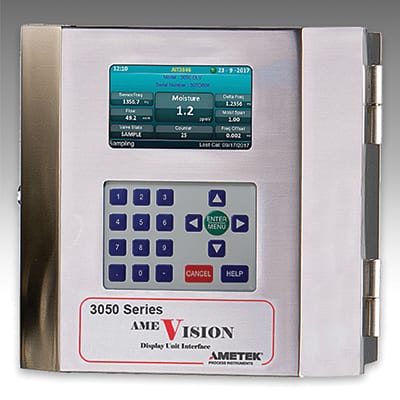
Ametek
This company has broadened its AMEVision communication and display system capabilities to include the 3050 Series of moisture analyzers (photo). Originally designed for WDG-V analyzers, the AMEVision system provides realtime moisture measurements and trend data while also detailing a variety of maintenance and troubleshooting information. Users can now continually monitor the measurement and diagnostic information for up to eight 3050 Series moisture analyzers. AMEVision enables the convenience of on-site calibration and communication with analyzers via Modbus RS485 and Ethernet LAN. — Ametek Process Instruments, a unit of Ametek, Inc., Pittsburgh, Pa.
An analyzer for residual gases in vacuum systems
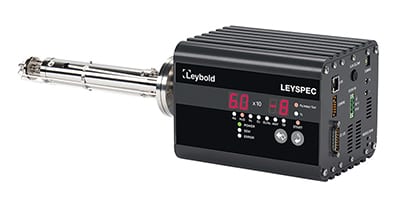
Leybold
The Leyspec (photo) is designed for efficient residual-gas analysis in high and ultra-high vacuum systems. Due to its compact size and flexible mountability, the device is suitable for very different installation situations and measuring tasks in research and industry. Equipped with an integrated display, users can display the partial pressures of the relevant gases at any time. If the user is interested in an additional gas in his or her process, another channel can be individually assigned to it. The intelligent software offers users various analysis options from which they can choose. Additional test procedures and functionalities are pre-installed, such as the helium leak test or the setting of warnings and error limits for certain gases. — Leybold GmbH, Cologne, Germany
A transmitter for analytical sensors where space is limited
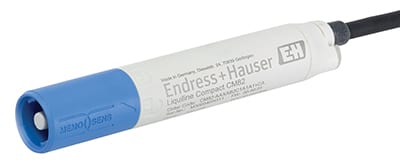
Endress+Hauser
The Liquiline compact CM82 transmitter (photo, p. 26) accepts pH, ORP, pH/ORP, conductivity, oxygen and chlorine sensor signals from this company’s Memosens sensor platform. Its housing is only 11 cm long and 2 cm wide, so even combined with the sensor, it fits into almost every assembly, says the company. Although small, it is a fully developed multiparameter transmitter, with access available via 4–20-mA HART, or Bluetooth from any iOS or Android device. The CM82 reads all sensor and calibration data stored in the head of a Memosens sensor. As a result, the sensor is automatically detected within seconds, and the measurement is immediately ready for use after a sensor change. — Endress+Hauser, Greenwood, Ind.
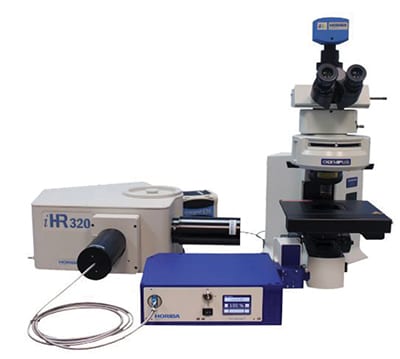
Horiba Scientific
Add spectroscopy to any standard microscope
With its unique set of accessories, the new Standard Microscope Spectroscopy (SMS) family of systems (photo) enable any standard microscope to be fitted with a spectrometer and a detector, thereby offering the ability to perform techniques such as Raman, steady-state and time-resolved photoluminescence, reflectance/transmittance, electroluminescence, photocurrent and dark-field scattering. The SMS platform brings unprecedented flexibility and modularity to performing spectroscopy on standard microscope systems, all without compromising the imaging functionality of the microscope. “Multitask your Microscope” is the theme behind these SMS systems. — Horiba Scientific, Div. Horiba Instruments, Inc., Piscataway, N.J.
Attachments for this handheld Raman system
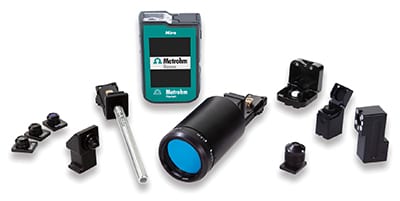
Metrohm
The new Mira Flex package (photo) permits customization of the Mira handheld Raman analyzer for unique applications. The basic package includes a Mira device, USB cable, calibration standard and laser safety glasses. Users can then simply select the available Smart Attachments and accessories that meet their specific sampling needs. For sampling through a container, the Working Distance Attachments (SWD, LWD, XLWD, or UA) can handle everything from direct contact to 22-mm glass containers. For determining the toxicity of an unknown material, the Standoff Attachment enables safe sampling from a distance. Checking the formulation of a tablet is performed with the Tablet Holder. The Ball Probe Attachment allows sampling by direct contact, for instance, in a barrel where a proper focus is not required. Mira is a fast, easy, reliable and flexible solution for identification and verification of materials. — Metrohm AG, Herisau, Switzerland
A cross-pipe version of this TDL gas analyzer
With most tunable diode laser (TDL) gas analyzers, loss of alignment leading to loss of measurement signal during a running process can be a constant problem. The Cross-Pipe GPro 500 analyzer means maintaining alignment is no longer an issue. The GPro 500 series of TDLs solves the alignment issue by combining both the source and the sensor into a single unit. A probe attached to the sensor features a corner cube at its end that redirects the laser beam back to the sensor; therefore, loss of alignment is not possible. The probe concept is highly reliable in stacks with a diameter of less than 1 m. For wider stacks, where gas concentration is not constant, the company has introduced the Cross-Pipe GPro 500, thereby extending the application coverage of its GPro 500 family. A newly developed, two-dimensional corner cube array is positioned in the pipe, opposite the analyzer head. Exact alignment is not required. — Mettler-Toledo Process Analytics, Inc., Bellerica, Mass.
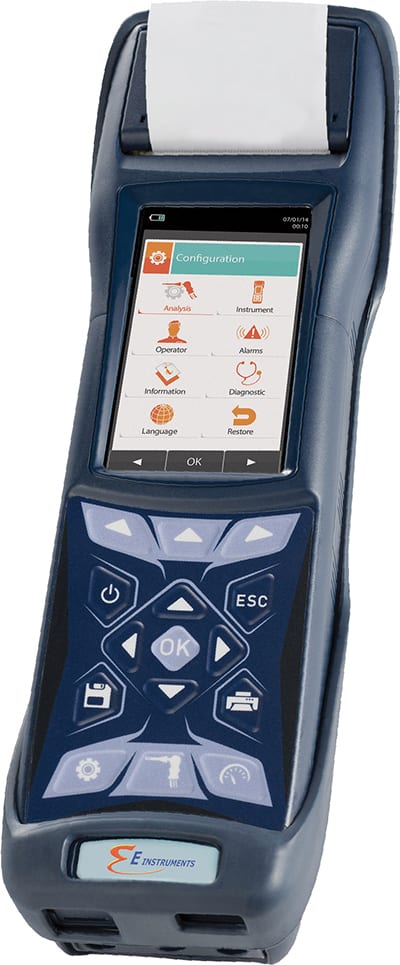
E Instruments International
Analyze industrial combustion gas with this handheld device
The E1500 handheld combustion emissions analyzer (photo) is a rugged unit with the ability to measure carbon monoxide and oxygen from high-efficiency and condensing boilers, burners, engines, turbines, kilns, furnaces, incinerators and other industrial combustion processes. Featuring a new, large color display and expanded internal memory, the E1500 lets users see and save sample data without worrying about running out of memory. The E1500 also features pre-calibrated, field-replaceable sensors that allow for easy diagnostics and replacement to reduce downtime and costly repair charges. — E Instruments International, Langhorne, Pa.